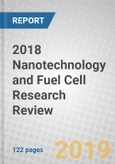Report Scope
In recent years, nanotechnology has gained popularity across the world with advanced and modernized innovations in various applications including composite materials, nanoparticles, fabrication technologies, small machine equipment manufacturing and many others. Essentially, nanotechnology is deeply integrated in various industrial applications, providing advances in process delivery and costeffective applications in industries such as food and beverage, healthcare and life science, electronics, energy, aerospace, chemical and many others.
Specifically, nanotechnology is being prominently used in fuel cell applications, as the fuel cell manufacturers applying platinum nanoparticles to lower the amount of platinum in cells for cost reduction. With surge in fuel cell electric vehicle production, nanotechnology application in fuel cell is expected to increase further. U.S. Department of Energy, The National Renewable Energy Laboratory (U.S.), and Union of Concerned Scientists (U.S.) are doing research for hydrogen powered fuel cell to make it more efficient, low cost and commercially viable.
Moreover, miniaturization in the electronic industry is leading to the introduction of new semiconductor manufacturing processes. For integrated circuits (ICs), comprising of nanofiber are expericing great demand in the industry. Nanofiber can withstand high amount of heat generated in electric power modules and exhibits good conductivity.
In recent years, nanotechnology has gained popularity across the world with advanced and modernized innovations in various applications including composite materials, nanoparticles, fabrication technologies, small machine equipment manufacturing and many others. Essentially, nanotechnology is deeply integrated in various industrial applications, providing advances in process delivery and costeffective applications in industries such as food and beverage, healthcare and life science, electronics, energy, aerospace, chemical and many others.
Specifically, nanotechnology is being prominently used in fuel cell applications, as the fuel cell manufacturers applying platinum nanoparticles to lower the amount of platinum in cells for cost reduction. With surge in fuel cell electric vehicle production, nanotechnology application in fuel cell is expected to increase further. U.S. Department of Energy, The National Renewable Energy Laboratory (U.S.), and Union of Concerned Scientists (U.S.) are doing research for hydrogen powered fuel cell to make it more efficient, low cost and commercially viable.
Moreover, miniaturization in the electronic industry is leading to the introduction of new semiconductor manufacturing processes. For integrated circuits (ICs), comprising of nanofiber are expericing great demand in the industry. Nanofiber can withstand high amount of heat generated in electric power modules and exhibits good conductivity.
Table of Contents
Chapter 1 ForewordChapter 2 Materials for Proton Exchange Membranes and Membrane Electrode Assemblies for PEM Fuel Cells (FCB035F)
- Introduction
- Study Goals and Objectives
- Reasons for Doing This Study
- Intended Audience
- Scope of Report
- Methodology
- Information Sources
- Geographic Breakdown
- Analyst's Credentials
- Custom Research
- Related Reports
- Summary
- Fuel Cell Technology
- Alkaline Fuel Cells
- Phosphoric Acid Fuel Cells
- Solid Oxide Fuel Cells
- Molten Carbonate Fuel Cells
- Aluminum-air Fuel Cells
- PEMFC Component Overview
- Proton Exchange Membrane Fuel Cell Fundamentals
- Fuel and Fuel Reforming Fundamentals
- The Direct Methanol Fuel Cell Variation
- Proton Exchange Membrane Fuel Cell Companies
- Market Segmentation and Industry Concentration
Chapter 3 Nanocomposites, Nanoparticles, Nanoclays and Nanotubes: Global Markets to 2022 (NAN021H)
- Introduction
- Study Goals and Objectives
- Reasons for Doing This Study
- Scope of Report
- Information Sources
- Methodology
- Geographic Breakdown
- Analyst's Credentials
- Related Reports
- Summary
- General Description
- Definitions
- Brief History of Nanocomposites
- General Properties of Nanocomposites vs. Conventional Composites
- Increased Tensile Strength, Modulus, and Heat Distortion Temperature
- Color/Transparency
- Conductivity
- Flame Retardancy
- Barrier Properties
- Anticorrosive Properties
- Types of Nanocomposites, Their Properties and Applications
- Clay Nanocomposites
- Ceramic Nanocomposites
- Carbon Nanotube Composites
- Metal-Containing Nanocomposites
- Metal Oxide-Containing Nanocomposites
- Nanobiocomposites
Chapter 4 Global Markets and Technologies for Nanofibers (NAN043E)
- Introduction
- Study Goals and Objectives
- Reasons for Doing This Study
- Intended Audience
- Scope of Report
- Methodology and Information Sources
- Market Breakdown
- Analyst's Credentials
- Related Reports
- Summary
- Nanomaterials and Nanofibers
- The Nanotechnology Industry
- Milestones in the History of Nanofibers and Recent Events
- Current and Emerging Applications for Nanofibers
Chapter 5 Nanodevices and Nanomachines: The Global Market (NAN062A)
- Introduction
- Reasons for Doing This Study
- Study Goals and Objectives
- Scope of Report
- Information Sources
- Methodology
- Regional Breakdown
- Analyst's Credentials
- Related Reports
- Summary
- Background
- Definitions
- General Properties of Nanoscale Materials and Systems
- Brief History of Nanomachines
- Major Technology Segments
- Nanomanipulators
- Nanotools
- Nanosensors
- Nanoscale Computing Devices
- Nanorobots
- Other Nanomachines
- Fabrication Approaches
- Top-Down Approach
- Bottom-Up Approach
- Hybrid Top-Down Bottom-Up Approach
- Bio-Hybrid Approach
- End Users and Applications
- Research
- Healthcare
- Microelectronics and Information Technology
- Process Industries
- Energy
- Environmental Protection
- Public Safety and Security
- Military
Chapter 6 Residential Energy Storage, Blockchain and Energy Sharing Systems: Technologies and Global Market (FCB043A)
- Introduction
- Study Goals and Objectives
- Reasons for Doing This Study
- Scope of Report
- Information Sources
- Methodology
- Geographic Breakdown
- What the Industry is Saying
- Analyst's Credentials
- Related Reports
- Summary
- Market and Technology Background
- Construction of Batteries
- Types of Electrochemical Compositions
- Residential Battery Storage Technologies and Components
- Battery Pack Design
- Design Overview
- Configuration of Cells in a Battery Pack
- Battery Pack Structural Design
- Cell Protection
- Battery Pack Control (Monitoring and Management)
- Battery Pack Use
- Solar Inverter Integration
- Safety System Design and Component Selection
- Residential Battery Storage Electrochemical Technologies
- Conventional Batteries
- How Rechargeable Batteries Work
- Lead-Acid Batteries








